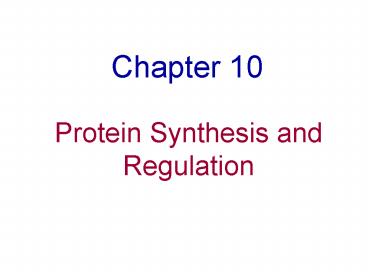Protein Synthesis and Regulation - PowerPoint PPT Presentation
1 / 36
Title:
Protein Synthesis and Regulation
Description:
1) brings an amino acid to the ribosome. 2) has anticodon to match codon of m-RNA ... a. substitution - changes one amino acid in protein ... – PowerPoint PPT presentation
Number of Views:58
Avg rating:3.0/5.0
Title: Protein Synthesis and Regulation
1
Chapter 10
- Protein Synthesis and Regulation
2
III. Protein Synthesis
- A. DNA is code nucleus
- 1. exists in the nucleus
- 2. transcription makes an RNA strand
- 3. RNA strand moves to cytoplasm
- 4. RNA used to synthesize proteins
3
(No Transcript)
4
III. Protein Synthesis
- B. Transcription
- 1. Definition - make RNA
- 2. Procedure
- a. RNA polymerase reads the DNA and matches the
bases - b. RNA polymerase attaches incoming bases to the
new strand but not permanently to the DNA
5
(No Transcript)
6
(No Transcript)
7
III. Protein Synthesis
- B. Transcription
- 1. Definition - make RNA
- 2. Procedure
- a. RNA polymerase reads the DNA and matches the
bases - b. RNA polymerase attaches incoming bases to the
new strand but NOT to the DNA - c. creates a strand of RNA
- d. RNA moves to cytoplasm
8
III. Protein Synthesis
- B. Transcription
- 3. three types of RNA used for translation
9
III. Protein Synthesis
- B. Transcription
- 3. three types of RNA used for translation
- a. m-RNA
- 1) is the code
- 2) read 3 nucleotides at a time codon
- 3) each codon codes for one amino acid
10
Fig. 10.1
11
Table 10.1
12
III. Protein Synthesis
- B. Transcription
- 3. three types of RNA used for translation
- a. m-RNA
- b. r-RNA
- 1) assembles the protein chain
- 2) p-site holds amino acid chain
- 3) a-site is for incoming amino acid
- 4) reaction site for condensation (dehydration
synthesis) - 5) e-site for ejection of empty t-RNA
13
Fig. 10.4
A
P
14
Fig. CO 9
15
III. Protein Synthesis
- B. Transcription
- 3. three types of RNA used for translation
- a. m-RNA
- b. r-RNA
- c. t-RNA
- 1) brings an amino acid to the ribosome
- 2) has anticodon to match codon of m-RNA
- 3) each amino acid anticodon has specific amino
acid
16
Fig. 9.14
17
III. Protein Synthesis
- C. Translation
- 1. Definition - make a protein
- 2. Process
18
Fig. 9.16
19
III. Protein Synthesis
- C. Translation
- 1. Definition - make a protein
- 2. Procedure
- a. initiation
- b. elongation
- c. termination
20
Fig. 9.15
21
III. Protein Synthesis
- D. How mRNA works
22
Fig. 9.17
23
III. Protein Synthesis
- Recap
- SKIP
- gene families, transposons
24
Fig. 9.18
25
III. Protein Synthesis
- D. Regulation in Prokaryotes
- 1. regulatory sites
- a. promoters beginning of a gene indicates
start of code - b. operator after promoter - controls access
to rest of gene - c. repressor binds to operator - turns off gene
- d. activator binds before gene and allows RNA
polymerase to bind to promoter - e. inducer binds to repressor so gene is turned
on
26
III. Protein Synthesis
- D. Regulation in Prokaryotes
- 2. example - operon theory
- a. lac operon
- b. bacteria
27
Fig. 9.19
28
III. Protein Synthesis
- E. Regulation in Eukaryotes
- 1. chromosome level - DNA packing
- 2. transcription level - regulators on DNA
- 3. transcript level - introns and exons
- 4. exit nucleus - improper sequences held back
- 5. degrade RNA in cytoplasm
- 6. translation - regulators on message
- 7. protein level - modification of inactive
protein, degrade active protein
29
(No Transcript)
30
IV. Mutations
- A. Mechanisms
- 1. Damage to DNA
- a. x-rays - break DNA strands
- b. UV - changes bonds in bases
- c. chemicals - change bases themselves
- 2. Errors in replication
31
Table 9.1
32
IV. Mutations
- B. Types of Mutations
- 1. point mutations
- a. substitution - changes one amino acid in
protein
33
Fig. 9.23
34
IV. Mutations
- B. Types of Mutations
- 1. point mutations
- a. substitution - changes one amino acid in
protein - b. insertion or deletion - changes order of the
bases and so changes all of the amino acids
35
Fig. 9.23
36
IV. Mutations
- B. Types of Mutations
- 2. whole chromosome mutations
- a. inversion
- b. translocation
- c. deletion/insertion
- d. duplication

